Understanding Plastic Additives Enhancing Performance and Functionality
Plastics have become an integral part of our daily lives, permeating nearly every industry and application. From packaging materials to automotive components and medical devices, plastics are valued for their versatility and durability. However, the raw polymer materials used to manufacture plastics often require enhancement to meet specific performance requirements. This is where plastic additives come into play.
Plastic additives are substances added to polymer materials to modify their properties and enhance their performance. These additives can improve aspects such as flexibility, rigidity, durability, processability, and resistance to environmental factors. The use of additives allows manufacturers to tailor plastics to suit specific applications, thereby expanding their utility across various sectors.
Types of Plastic Additives
1. Stabilizers These additives are crucial for protecting plastics from degradation caused by heat, light, and oxygen exposure. Common stabilizers include antioxidants and UV stabilizers, which help in maintaining the integrity of plastic products over time, especially for applications exposed to harsh environmental conditions.
2. Plasticizers Often used to soften rigid plastics, plasticizers make materials more flexible and easier to process. They work by disrupting the intermolecular forces within the polymer matrix. Phthalates have been widely used as plasticizers, although concerns over health impacts have led to a search for safer alternatives.
3. Fillers Fillers are added to enhance the bulk and improve the mechanical properties of plastics. They can reduce production costs by replacing some of the polymer content and often improve specific attributes such as strength, thermal stability, and barrier properties. Common fillers include calcium carbonate, talc, and glass fibers.
4. Flame Retardants These additives increase the fire resistance of plastic products, making them safer for various applications, especially in construction and electronics. Flame retardants can be classified into halogenated and non-halogenated types, each with different mechanisms of action and environmental impacts.
plastic additives list

5. Antimicrobials In applications such as healthcare and food packaging, antimicrobial additives are employed to inhibit the growth of bacteria, fungi, and other microorganisms on the surface of plastics. This is particularly important for maintaining hygiene and extending the shelf life of products.
6. Colorants Colorants, including dyes and pigments, are used to enhance the visual appeal of plastic products. They allow manufacturers to produce a wide range of aesthetically pleasing items while also providing additional functionalities, such as UV protection in some cases.
7. Processing Aids These additives facilitate the processing of plastics during manufacturing. They can improve the flow of the molten polymer through machinery and enhance the overall processing efficiency. Common processing aids include lubricants and release agents.
Environmental Considerations
As the demand for environmentally friendly products grows, the plastic industry faces pressure to develop sustainable additives and materials. Biodegradable additives and naturally derived plasticizers are gaining traction as alternatives to traditional substances that may lead to pollution and health hazards. Additionally, the recycling of plastics is another area where additives play a significant role. Certain additives can be designed to enhance the recyclability of plastics, making the entire lifecycle of plastic products more sustainable.
Conclusion
Plastic additives serve a critical function in modifying the properties and performance of various plastic products. By understanding the diverse types of additives available, manufacturers can create tailored solutions that meet specific needs across different applications. As the industry moves towards sustainability, the development of eco-friendly additives will be crucial in minimizing the environmental impact of plastic products while maintaining their essential qualities. The future of plastics lies in the careful balance of performance enhancement through additives and the commitment to environmental responsibility.

